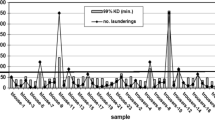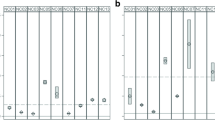Abstract
The protective effectiveness of factory-based permethrin-impregnated polymer-coated battle dress uniforms (PTBDUs) against tick bites was evaluated at four military training areas in southwestern and central Germany where tick bite incidence is known to be high. Data were analyzed by comparing tick bite incidence using non-permethrin-treated BDUs (NTBDUs) during 2009 versus PTBDUs during 2010 and 2011, the first two years after their formal introduction for in-country use in the German Bundeswehr. During 2009, 262 individual tick bites were reported at the four training sites, resulting in a tick bite incidence of 8.8 % per exposed person when wearing NTBDUs only. In 2010 and 2011, one tick bite case occurred under field conditions each year that PTBDUs were worn, corresponding to a protective effectiveness of 99.6 and 98.6 %. These data imply an annual tick bite incidence of 0.035 and 0.078 % per exposed person, respectively. Between 2010 and 2011, a 0.8 % decline in the protective effectiveness of PTBDUs was observed. Five tick bite incidents occurred while wearing non-impregnated parkas over correctly worn PTBDUs. Ixodes ricinus ticks were collected by standard tick drags from 2009 to 2011, with high mean annual densities ranging from 28.9 to 106.5 ticks per 100 m2, while single drags revealed tick densities between zero and 381 ticks per 100 m2. Overall, 4596 I. ricinus ticks (54 ♂, 82 ♀, 1776 nymphs, and 2684 larvae) were collected, of which 128 (2.8 %; mean annual range, 0–10.1 %) were Borrelia burgdorferi s.l. positive. The Borrelia genospecies distribution was as follows: 112 (87.5 %) Borrelia afzelii, 10 (7.8 %) B. burgdorferi s.s., and 6 (4.7 %) Borrelia garinii. Neither the tick density means from 2009 to 2011 nor associated B. burgdorferi s.l. prevalences differed significantly among the military locations investigated. The documented tick bite reductions clearly demonstrate the powerful protective effectiveness of properly worn PTBDUs against tick bites. Nevertheless, all apparel worn over PTBDUs should also be impregnated with permethrin in order to prevent tick infestation and subsequent bites.

Similar content being viewed by others
References
Anonymous (2008) Verordnung zur Rechtsvereinfachung und Stärkung der arbeitsmedizinischen Vorsorge. Bundesgesetzbl 62:2768–2779
Appel KE, Gundert-Remy U, Fischer H, Faulde M, Mross KG, Letzel S, Rossbach B (2008) Risk assessment of Bundeswehr (German Federal Armed Forces) permethrin-impregnated battle dress uniforms (BDU). Int J Hyg Environ Health 211:88–104
Banks SD, Murray N, Wilder-Smith A, Logan JG (2014) Insecticide-treated clothes fort he control of vector-borne diseases: a review on effectiveness and safety. Med Vet Entomol 28(S1):14–25
Due C, Fox W, Medlock JM, Pietzsch M, Logan JG (2013) Tick prevention and tick removal. BMJ 347:f7123
Dutkiewicz J, Cisak E, Sroka J, Wojcik-Fatla A, Zajac V (2011) Biological agents as occupational hazards—Selected issues. Ann Agric Environ Med 18:286–293
Estrada-Peña A, Ortega C, Sánchez N, DeSimone L, Sudre B, Suk JE, Semenza JC (2011) Correlation of Borrelia burgdorferi sensu lato prevalence in questing Ixodes ricinus ticks with specific abiotiv traits in the Western Palearctic. Appl Environ Microbiol 77:3838–3845
Faulde MK, Robbins RG (2008) Tick infestation risk and Borrelia burgdorferi a.l. infection-induced increase in host finding efficacy of female Ixodes ricinus under natural conditions. Exp Appl Acarol 44:137–145
Faulde MK, Uedelhoven WM, Robbins RG (2003) Contact toxicity and residual activity of different permethrin-based fabric impregnation methods for Aedes aegypti (Diptera: Culicidae), Ixodes ricinus (Acari: Ixodidae), and Lepisma saccharina (Thysanura: Lepismatidae). J Med Entomol 40:935–941
Faulde MK, Uedelhoven WM, Malerius M, Robbins RG (2006) Factory-based permethrin impregnation of uniforms: Residual activity against Aedes aegypti and Ixodes ricinus in battle dress uniforms worn under field conditions, and cross contamination during the laundering and storage process. Mil Med 171:472–477
Faulde M, Scharninghausen J, Tisch M (2008) Preventive effect of permethrin impregnated clothing for humans exposed to Ixodes ricinus ticks and associated Borrelia burgdorferi s.l. in Germany. Int J Med Microbiol 298(S1):321–324
Faulde M, Rutenfranz M, Hepke J, Rogge M, Görner A, Keth A (2014) Human tick infestation pattern, tick-bite rate and associated Borrelia burgdorferi s.l.-infection risk during occupational tick exposure at the Seedorf military training area, northwestern Germany. Ticks Tick Borne Dis 5(5):594–599
Ferquel E, Garnier M, Marie J, Bernede-Bauduin C, Baranton G, Pérez-Eid C, Postic D (2006) Prevalence of Borrelia burgdorferi sensu lato and Anaplasmataceae members in Ixodes ricinus in Alsace, a focus of lyme borreliosis endemicity in France. Appl Environ Microbiol 72:3074–3078
Franke J, Hildebrandt A, Dorn W (2013) Exploring gaps on our knowledge on Lyme borreliosis spirochaetes—Updates on complex heterogeneity, ecology, and pathogenicity. Ticks Tick Borne Dis 4:11–25
Ginsberg HS, Faulde MK (2008) Ticks. In: Bonnefoy X, Kampen H, Sweeney K (eds) Public health significance of urban pests. World Health Organization, Regional Office for Europe, Copenhagen, pp 303–345
Herrmann C, Gern L (2010) Survival of Ixodes ricinus (Acari: Ixodidae) under challenging conditions of temperature and humidity is influenced by Borrelia burgdorferi sensu lato infection. J Med Entomol 47:1196–1204
Hildebrandt A, Schmidt KH, Wilske B, Dorn W, Straube E, Fingerle V (2003) Prevalence of four species of Borrelia burgdorferi sensu lato and coinfection with Anaplasma phagocytophila in Ixodes ricinus ticks in central Germany. Eur J Clin Microbiol Infect Dis 22:364–367
Hillyard PD (1996) Ticks of north-west Europe. Linnaean Society, London
International Organization for Standardization (ISO) (2009) Domestic washing and drying procedures for textile testing. EN ISO 6330:2000, amended 2009. Available from www.iso.org
Lieboldt T (2007) Anwendung der Biostoffverordnung bei Borrelienexposition: Auswirkungen auf den Dienstbetrieb der Bundeswehr. Wehrmed Wehrpharm 31:66–69
Margos G, Vollmer SA, Cornet M, Garnier M, Fingerle V, Wilske B, Bormane A, Vitorino L, Collares-Pereira M, Drancourt M, Kurtenbach K (2009) A new Borrelia species defined by multilocus sequence analysis of housekeeping genes. Appl Environ Microbiol 75:5410–5416
Miller NJ, Rainone EE, Dyer MC, Gonzalez ML, Mather TN (2011) Tick bite protection with permethrin-treated summer-weight clothing. J Med Entomol 48:327–333
Rahlenbeck S, Fingerle V (2014) Wie man sich vor Zecken schützt. Dt Ärztebl 111:A 1142–A 1143
Rauter C, Hartung T (2005) Prevalence of Borrelia burgdorferi sensu lato genospecies in Ixodes ricinus ticks in Europe: a metaanalysis. Appl Environ Microbiol 71:7203–7216
Richter D, Matuschka F-R (2011) Differential risk for Lyme disease along a hiking trail, Germany. Emerg Infect Dis 17:1704–1706
Rizzoli A, Hauffe HC, Carpi G, Vourc HG, Neteler M, Rosà R (2011) Lyme borreliosis in Europe. Euro Surveill 16(27)
Schwarz A, Hönig V, Vavrušková Z, Grubhoffer L, Balczun C, Albring A, Schaub GA (2012) Abundance of Ixodes ricinus and prevalence of Borrelia burgdorferi s.l. in the nature reserve Siebengebirge, Germany, in comparison to three former studies from 1978 onwards. Parasit Vectors 21:268
Stanek G, Wormser GP, Gray J, Strle F (2012) Lyme borreliosis. Lancet 379:461–473
Tijsse-Klasen E, Pandak N, Hengeveld P, Takumi K, Koopmans MPG, Sprong H (2013) Ability to cause erythema migrans differs between Borrelia burgdorferi sensu lato isolates. Parasit Vectors 6:23
Vaughn MF, Meshnick SR (2011) Pilot study assessing the effectiveness of long-lasting permethrin-impregnated clothing for the prevention of tick bites. Vector Borne Zoonotic Dis 11:869–875
Vaughn MF, Funkhouser SW, Lin F-C, Fine J, Juliano JJ, Apperson CS, Meshnick SR (2014) Long-lasting permethrin impregnated uniforms: a randomized-controlled trial for tick bite prevention. Am J Prev Med 46:573–480
Zimmer J, Faulde M (2009) Biomonitoring in the German armed forces: Focusing on risk assessments during deployments. Clin Chem Lab Med 47:A42–A43
Acknowledgments
The authors thank Ms. Anke Crecelius and Mr. Bernd Bocklet for laboratory support. Thanks also to the numerous preventive medicine technicians who assisted in monitoring local tick populations. Dr. Richard G. Robbins, Armed Forces Pest Management Board, Office of the Deputy under Secretary of Defense for Installations and Environment, Washington, DC, helpfully reviewed and commented on an earlier version of our manuscript. This manuscript represents, in part, the thesis of Mr. Martin Rutenfranz.
Conflict of interest statement
The authors declare that there are no conflicts of interest.
Author information
Authors and Affiliations
Corresponding author
Rights and permissions
About this article
Cite this article
Faulde, M.K., Rutenfranz, M., Keth, A. et al. Pilot study assessing the effectiveness of factory-treated, long-lasting permethrin-impregnated clothing for the prevention of tick bites during occupational tick exposure in highly infested military training areas, Germany. Parasitol Res 114, 671–678 (2015). https://doi.org/10.1007/s00436-014-4232-y
Received:
Accepted:
Published:
Issue Date:
DOI: https://doi.org/10.1007/s00436-014-4232-y




